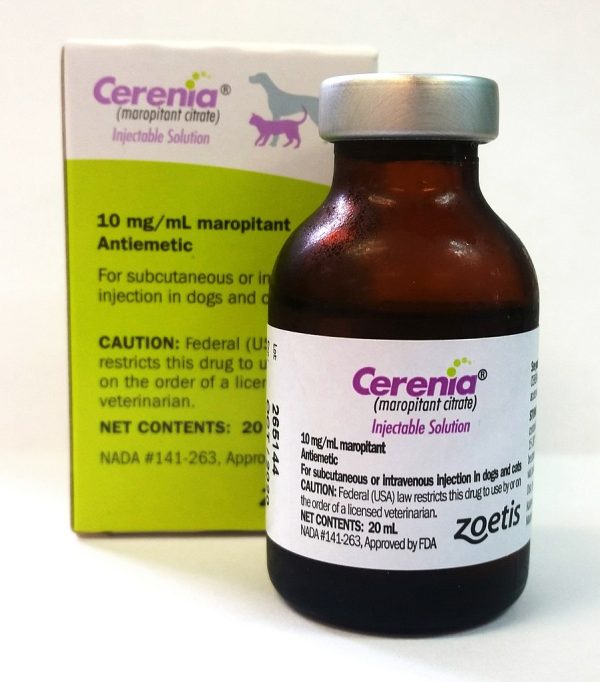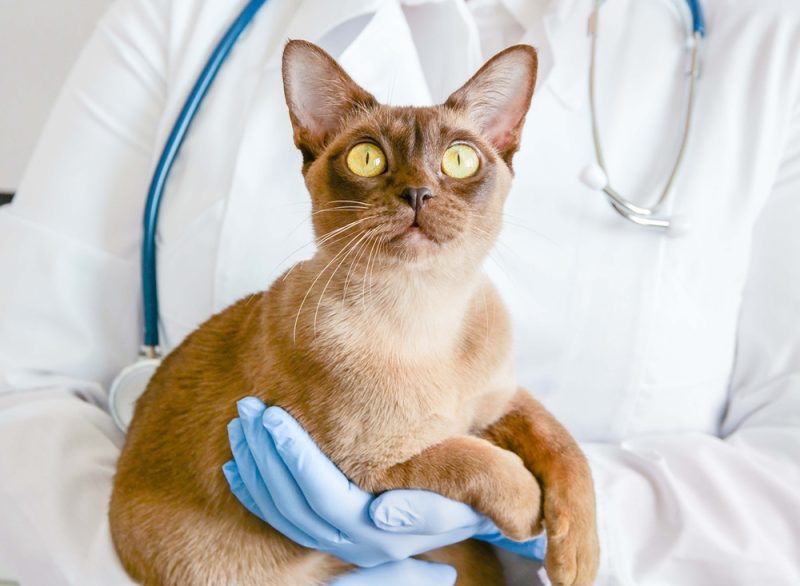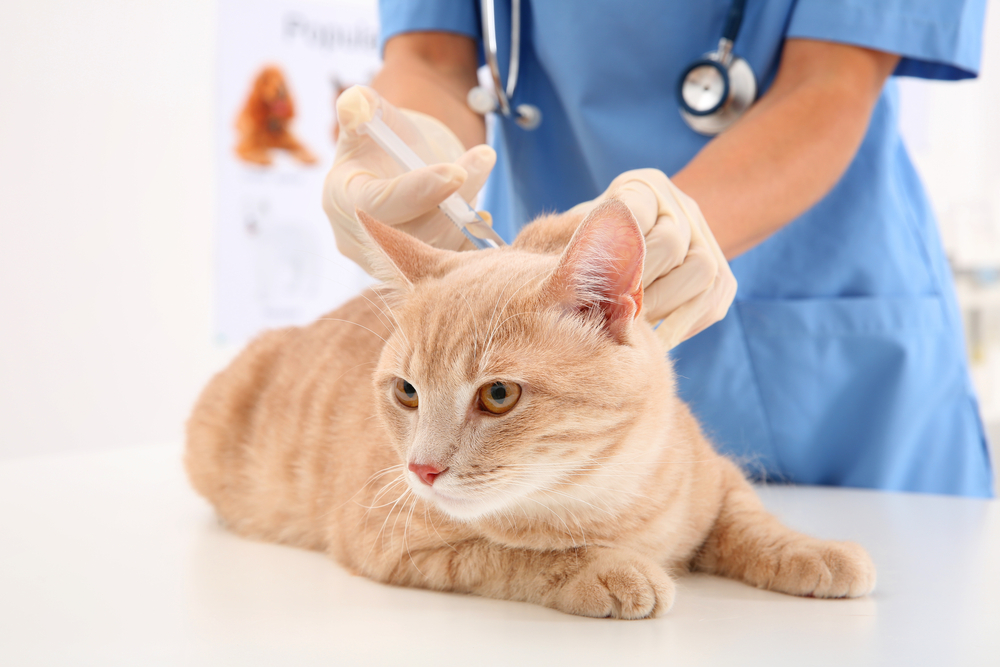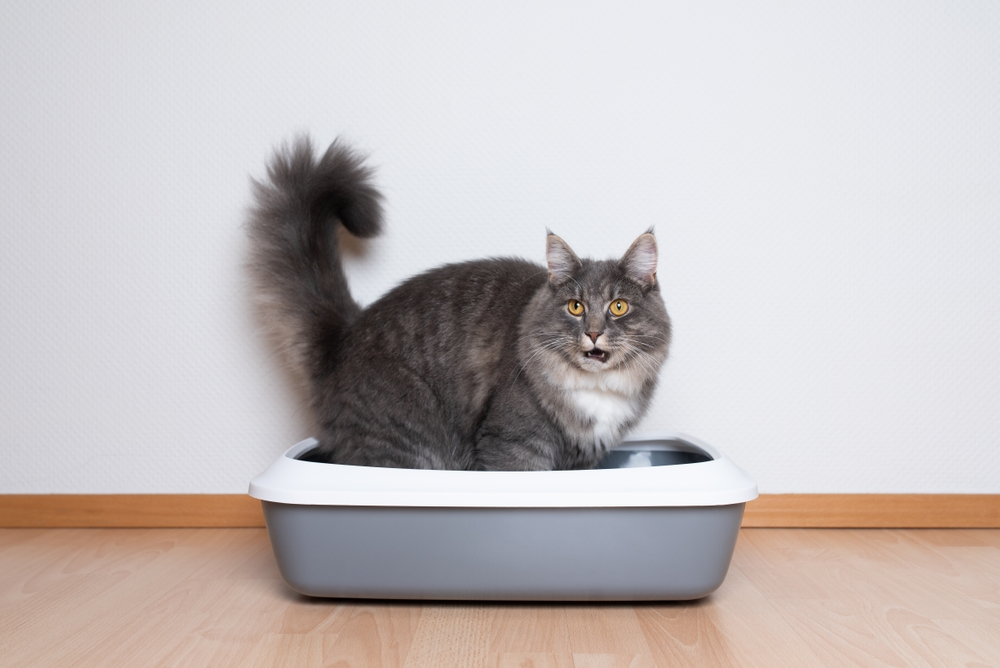Click to Skip Ahead
It can be highly stressful as a cat owner when your feline is sick. If your cat has a bug causing them to vomit, has nausea, or has belly pain, they might be given an injection of Cerenia by their veterinarian. But what is Cerenia? How does it work? And is it a safe medication for your feline friend?

Key Points
- Cerenia is one of the trade names of a drug called Maropitant.
- Maropitant is an anti-emetic or anti-vomiting medication that can be used in cats and dogs.
- Pharmaceutical company Zoetis makes Cerenia.
- Cerenia is a prescription-only medication, meaning it needs to be prescribed by your veterinarian.
- Cerenia is available as an injection with a concentration of 10mg/ml and in various tablet sizes (16mg, 24mg, 60mg, and 160mg).
- The injectable form of Cerenia is licensed for use in dogs and cats, but the tablets are only approved for dogs.
- Cerenia can be used in cats over 16 weeks of age.
If you need to speak with a vet but can't get to one, head over to PangoVet. It's an online service where you can talk to a vet online and get the advice you need for your pet — all at an affordable price!
Uses of Cerenia in Cats

Cerenia is licensed to treat and prevent vomiting and nausea in cats. However, unlike in dogs, it is not yet licensed to treat motion sickness or nausea and vomiting caused by chemotherapy. Although not licensed for these uses in cats, it may still be effective, and your veterinarian may occasionally suggest the off-license use of Cerenia for your cat. If this is the case, they will discuss the potential benefits and any possible risks before asking for your consent for the treatment.
Cerenia has also been found to provide some visceral pain relief, meaning it can ease pain associated with internal organs like the stomach and intestine. There is also some anecdotal reports that it has anti-inflammatory effects and can help relieve skin irritation and itchiness in some instances of feline allergic dermatitis.
How Is Cerenia Given to Cats?
Cerenia is available as both an injection and a tablet for dogs. However, only the injectable version is currently licensed for use in cats. The Cerenia dosage for cats is often given by a single injection of 1mg/kg under the skin, usually in the scruff of the neck or anywhere there is loose skin. The injection can cause a stinging sensation, which can last for up to a minute. This is especially common in cats compared to dogs.
The injection can also be given intravenously (directly into a vein). This method does not sting; however, it requires more restraint. The Cerenia injection can be repeated every 24 hours for up to 5 consecutive days if needed, but treatment should not be continued after 5 days.
The benefit of Cerenia tablets is that they can be given for up to 14 days and can more easily be used as a preventative. Although Cerenia tablets aren’t licensed for use in cats, some studies have suggested that they could be effective. However, the safety can’t be guaranteed until the necessary research has been completed and the license granted.

How Does Cerenia Work?
Vomiting is often initiated in the Vomiting Center or Chemoreceptor Trigger Zone within the brain or in the Vagus Nerve. These parts of the nervous system contain Neurokinin Receptors, which can trigger vomiting or nausea when they are bound to by a protein called Substance P. Maropitant is a Neurokinin 1 (NK1) receptor antagonist that prevents Substance P from binding to these receptors, therefore preventing the initiation of vomiting and reducing nausea.
What Are the Side Effects of Cerenia?
The most common side effect of Cerenia is the stinging pain that some cats experience during the injection process. This is transient, though, and should fade within a minute. Cerenia is often stored in the refrigerator to reduce the stinging sensation, but this can cause some cats to respond to the cool sensation rather than pain.
As with any medication, there is the risk of an allergic or anaphylactic reaction, but this risk is very minimal.
Does Cerenia React With Other Medications?
Cerenia can’t be used with calcium channel blockers, like amlodipine and diltiazem, because it relies on calcium channels for its method of action. It also binds to proteins within the bloodstream, so it might prevent other medications that bind to plasma proteins from being effective. This is because Cerenia is processed in the liver via cytochrome P450 enzymes. Other drugs that use the same pathway like antifungals and the anticonvulsant Phenobarbital might compete, leading to altered metabolism. Therefore, it’s worth ensuring your veterinarian is aware of any medications your cat is currently taking.
When Shouldn’t Cerenia Be Given?
The appropriate use of Cerenia is crucial. Because Cerenia suppresses the vomiting mechanism, it can mask a more significant illness. In cases where there is a blockage in the stomach or intestine, vomiting is vital to reduce the build-up of food and fluid. Therefore, if vomiting is suppressed with Cerenia when there is a gut obstruction, there is a risk of the stomach or intestine rupturing. Consequently, your cat must be examined by a veterinarian before using Cerenia, and the veterinarian should re-examine them if they continue to vomit or fail to improve.
If you have a kitten under 16 weeks of age, Cerenia may not be safe for them. However, a veterinarian may choose to use it off-license after discussing any potential risks with you. This is also the case for cats who are pregnant or lactating.
Some conditions could be made worse using Cerenia. The liver breaks down Cerenia, so it should only be used with caution in cats with liver failure or insufficiency. Equally, Cerenia can affect calcium and potassium channels, which are essential for normal heart function. Therefore, cats who have known heart disease should not be given Cerenia.

Frequently Asked Questions
How Long Does Cerenia Last in Cats?
A Cerenia injection for cats lasts for 24 hours and can be repeated daily for up to 5 consecutive days.
Can Cats Take Cerenia Every Day?
Cats can have a Cerenia injection daily for 5 consecutive days. However, they should not have a longer course than that. Dogs can have tablets for up to 14 days, but Cerenia tablets are not currently licensed for use in cats. You should speak to your veterinarian if you think that Cerenia is not controlling your cat’s signs.

Should Cerenia Be Given With Food?
Cerenia tablets for dogs should ideally be given with a small amount of food. However, they are not licensed to be used in cats. Although this doesn’t necessarily mean that they are unsafe or ineffective, it does mean that there is an element of risk. If you decide with the help of your veterinarian that you would like to try Cerenia tablets for your cat, they will need your consent to use an unlicensed medication. In fact, Chewy Pharmacy offers a compounded oral liquid form of the Maropitant and according to their web page, this can also be used in cats. They also offer a transdermal compounded Maropitant medication for cats. You will need a veterinarian’s prescription to purchase these medications, but they might offer an alternative solution for your cat.
Can Cerenia Be Crushed for Cats?
Cerenia tablets may have a bitter taste, which becomes more pronounced if they are crushed, potentially causing your cat to drool heavily, so it is not recommended. Please note that Cerenia tablets are not licensed for use in cats, only the injection is licensed. However, your veterinarian might decide to use this treatment off-label or as a compounded medication.
Is Cerenia Safe for Cats Long-Term?
Cerenia is only licensed to be given as an injection for 5 consecutive days. However, conditions like kidney disease can cause long-term nausea and vomiting. Although long-term use of Cerenia is off-license, it may still be suitable for your cat. However, you must discuss this with your veterinarian first.

Conclusion
Cerenia is the trade name of the drug maropitant. Maropitant is a very effective anti-vomiting medication that can be used for short-term illness but may also have a place in the management of diseases causing long-term vomiting, like kidney failure. Cerenia can be safely used in your cat for 5 days according to its veterinary license. However, your veterinarian will be able to discuss whether alternative, off-license use of Cerenia is appropriate for your cat.
Related Reads:
- Clavamox for Cats: What it is and Side Effects (Vet Answer)
- Baytril (Enrofloxacin) for Cats: Uses, Doses, & Side Effects (Vet Answers)
Featured Image Credit: Africa Studio, Shutterstock












my oncologist had maropitant made into a compounded transdermal lotion for my cat
Hi Frank, thank you very much for reading us and for sharing your story.
I was hoping for a version of Cerenia that comes as an ear gel or topical equivalent.
Our cat gets oral Chlorambucil as part of his lymphoma treatment plan. He has also had to take daily Prednisolone in tablet form. He hates being pilled as he has had so many pills to take in the last 18 months.
If there is no Cerenia gel under development, is there another anti-nausea med. that is available in gel form?
He is doing very well — has been in remission for at least 6 months — but the WEAKEST LINK in his therapy plan is pilling itself which is very stressful for him and for us.
Thanks for any ideas you may have.
Dear Sandy,
thank you for your question. It's fantastic to hear that your cat is in remission. You must have gone through a very difficult time, but it’s great that everything is better now. As far as we know, there are no antiemetics available in gel form. We understand how challenging it can be to give pills to your cat. To make the process easier, we have compiled some valuable resources written by veterinarians that offer tips and strategies for successfully pilling your cat.
Here are a few suggestions you might find helpful:
– How to Give a Cat a Pill: 5 Easy Steps (Vet Answer) – https://www.catster.com/ask-the-vet/how-to-give-cat-a-pill/
– How to Give Your Cat Medication: Dr. Karyn’s Tips (with Video) – https://www.catster.com/felines-weekly/how-to-give-your-cat-medication-dr-karyns-tips/
Just copy and paste the URL into your browser.
Feel free to reach out if you have any further questions or need more assistance.